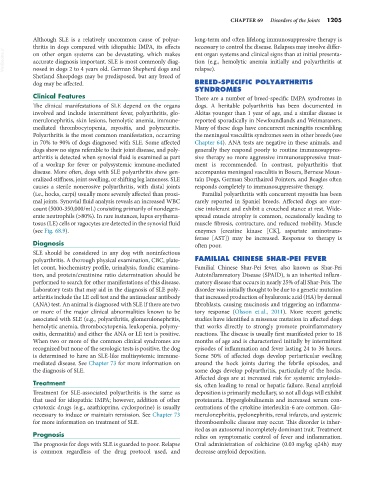Page 1233 - Small Animal Internal Medicine, 6th Edition
P. 1233
CHAPTER 69 Disorders of the Joints 1205
Although SLE is a relatively uncommon cause of polyar- long-term and often lifelong immunosuppressive therapy is
thritis in dogs compared with idiopathic IMPA, its effects necessary to control the disease. Relapses may involve differ-
VetBooks.ir on other organ systems can be devastating, which makes ent organ systems and clinical signs than at initial presenta-
tion (e.g., hemolytic anemia initially and polyarthritis at
accurate diagnosis important. SLE is most commonly diag-
nosed in dogs 2 to 4 years old. German Shepherd dogs and
Shetland Sheepdogs may be predisposed, but any breed of relapse).
dog may be affected. BREED-SPECIFIC POLYARTHRITIS
SYNDROMES
Clinical Features There are a number of breed-specific IMPA syndromes in
The clinical manifestations of SLE depend on the organs dogs. A heritable polyarthritis has been documented in
involved and include intermittent fever, polyarthritis, glo- Akitas younger than 1 year of age, and a similar disease is
merulonephritis, skin lesions, hemolytic anemia, immune- reported sporadically in Newfoundlands and Weimaraners.
mediated thrombocytopenia, myositis, and polyneuritis. Many of these dogs have concurrent meningitis resembling
Polyarthritis is the most common manifestation, occurring the meningeal vasculitis syndromes seen in other breeds (see
in 70% to 90% of dogs diagnosed with SLE. Some affected Chapter 64). ANA tests are negative in these animals, and
dogs show no signs referable to their joint disease, and poly- generally they respond poorly to routine immunosuppres-
arthritis is detected when synovial fluid is examined as part sive therapy so more aggressive immunosuppressive treat-
of a workup for fever or polysystemic immune-mediated ment is recommended. In contrast, polyarthritis that
disease. More often, dogs with SLE polyarthritis show gen- accompanies meningeal vasculitis in Boxers, Bernese Moun-
eralized stiffness, joint swelling, or shifting leg lameness. SLE tain Dogs, German Shorthaired Pointers, and Beagles often
causes a sterile nonerosive polyarthritis, with distal joints responds completely to immunosuppressive therapy.
(i.e., hocks, carpi) usually more severely affected than proxi- Familial polyarthritis with concurrent myositis has been
mal joints. Synovial fluid analysis reveals an increased WBC rarely reported in Spaniel breeds. Affected dogs are exer-
count (5000-350,000/mL) consisting primarily of nondegen- cise intolerant and exhibit a crouched stance at rest. Wide-
erate neutrophils (>80%). In rare instances, lupus erythema- spread muscle atrophy is common, occasionally leading to
tosus (LE) cells or ragocytes are detected in the synovial fluid muscle fibrosis, contracture, and reduced mobility. Muscle
(see Fig. 68.9). enzymes (creatine kinase [CK], aspartate aminotrans-
ferase [AST]) may be increased. Response to therapy is
Diagnosis often poor.
SLE should be considered in any dog with noninfectious
polyarthritis. A thorough physical examination, CBC, plate- FAMILIAL CHINESE SHAR-PEI FEVER
let count, biochemistry profile, urinalysis, fundic examina- Familial Chinese Shar-Pei fever, also known as Shar-Pei
tion, and protein/creatinine ratio determination should be Autoinflammatory Disease (SPAID), is an inherited inflam-
performed to search for other manifestations of this disease. matory disease that occurs in nearly 25% of all Shar-Peis. The
Laboratory tests that may aid in the diagnosis of SLE poly- disorder was initially thought to be due to a genetic mutation
arthritis include the LE cell test and the antinuclear antibody that increased production of hyaluronic acid (HA) by dermal
(ANA) test. An animal is diagnosed with SLE if there are two fibroblasts, causing mucinosis and triggering an inflamma-
or more of the major clinical abnormalities known to be tory response (Olsson et al., 2011). More recent genetic
associated with SLE (e.g., polyarthritis, glomerulonephritis, studies have identified a missense mutation in affected dogs
hemolytic anemia, thrombocytopenia, leukopenia, polymy- that works directly to strongly promote proinflammatory
ositis, dermatitis) and either the ANA or LE test is positive. reactions. The disease is usually first manifested prior to 18
When two or more of the common clinical syndromes are months of age and is characterized initially by intermittent
recognized but none of the serologic tests is positive, the dog episodes of inflammation and fever lasting 24 to 36 hours.
is determined to have an SLE-like multisystemic immune- Some 50% of affected dogs develop periarticular swelling
mediated disease. See Chapter 73 for more information on around the hock joints during the febrile episodes, and
the diagnosis of SLE. some dogs develop polyarthritis, particularly of the hocks.
Affected dogs are at increased risk for systemic amyloido-
Treatment sis, often leading to renal or hepatic failure. Renal amyloid
Treatment for SLE-associated polyarthritis is the same as deposition is primarily medullary, so not all dogs will exhibit
that used for idiopathic IMPA; however, addition of other proteinuria. Hyperglobulinemia and increased serum con-
cytotoxic drugs (e.g., azathioprine, cyclosporine) is usually centrations of the cytokine interleukin-6 are common. Glo-
necessary to induce or maintain remission. See Chapter 73 merulonephritis, pyelonephritis, renal infarcts, and systemic
for more information on treatment of SLE. thromboembolic disease may occur. This disorder is inher-
ited as an autosomal incompletely dominant trait. Treatment
Prognosis relies on symptomatic control of fever and inflammation.
The prognosis for dogs with SLE is guarded to poor. Relapse Oral administration of colchicine (0.03 mg/kg q24h) may
is common regardless of the drug protocol used, and decrease amyloid deposition.

